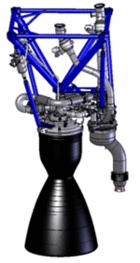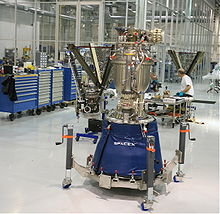Merlin Rocket Engine Video - Engine tests
|
|
Merlin
Merlin 1C

: Country of origin
: Manufacturer
: Liquid-fuelled engine
: Propellant
: Cycle
Performance:
: Thrust(Vac)
: Thrust(SL)
: Thrust-to-weight ratio
: Chamber pressure
: Isp(Vac)
: Isp(SL)
Dimensions:
: Diameter
Merlin is a rocket engine developed by SpaceX for use on its Falcon 1 and Falcon 9 rockets. Merlin uses RP-1 kerosene and liquid oxygen as propellants in a gas-generator power cycle. The Merlin engine is designed for sea recovery and reuse.
The injector at the heart of Merlin is of the pintle type that was first used in the Apollo Program for the lunar module landing engine.
Propellants are fed via a single shaft, dual impeller turbo-pump. The turbo-pump also provides high pressure kerosene for the hydraulic actuators, which then recycles into the low pressure inlet. This eliminates the need for a separate hydraulic power system and means that thrust vector control failure by running out of hydraulic fluid is not possible. A third use of the turbo-pump is to provide power to pivot the turbine exhaust nozzle for roll control purposes.
Variants
Three versions of the Merlin 1C engine are in production. The Merlin engine for Falcon 1 has a movable turbo-pump exhaust assembly which is used to provide roll control by vectoring the exhaust. The Merlin engine for the Falcon 9 first stage is nearly identical to the variant used for the Falcon 1 except that the turbo-pump exhaust assembly is not movable. Finally, the Merlin vacuum is used on the Falcon 9 second stage. This engine differs from the Falcon 9 first stage variant in that it uses a larger exhaust nozzle optimized for vacuum operation and can be throttled between 60 and 100 percent.
Revisions
Merlin 1A
The initial version, the Merlin 1A, used an inexpensive, expendable, ablatively cooled carbon fiber composite nozzle, and produced 77,000 lbf (340 kN)of thrust. The Merlin 1A flew only two times: First on 24 March 2006, when it caught fire and failed due to a fuel leak shortly after launch, and the second time on 21 March 2007, where it performed successfully. Both times the Merlin 1A was mounted on a Falcon 1 first stage.
The basic design of the first engine variant (including the same turbopump) was based on the abandoned FASTRAC NASA project which developed the similar Fastrac rocket engine at the end of 1990s.
Merlin 1B
The Merlin 1B rocket engine is an upgraded version of the Merlin engine developed by SpaceX for its Falcon 1 launch vehicles, capable of producing 85,000 lbf (380 kN) of thrust. The Merlin 1B has been enhanced over the 1A with a turbine upgrade (from 1490 kW to 1860 kW).
Initial use of the Merlin 1B was to be on the Falcon 9 heavy launch vehicle, on whose first stage there would have been a cluster of nine of these engines. Due to experience from the Falcon 1's first flight, the 1B will not be used on a flight vehicle. SpaceX has moved its Merlin development to the Merlin 1C, which is regeneratively cooled. Therefore the Merlin 1B was never in use on a launch vehicle.
Merlin 1C

Picture - Merlin 1C under construction at SpaceX factory
The Merlin 1C uses a regeneratively cooled nozzle and combustion chamber. It was fired with a mission duty firing of 170 seconds in November, 2007, and powered the Falcon 9 on its maiden flight.
As configured for use on Falcon 1 vehicles, the Merlin 1C had a sea level thrust of 78,000 lbf (350 kN), a vacuum thrust of 90,000 lbf (400 kN) and a vacuum specific impulse of 304 seconds. In this configuration the engine consumed 300 lb (140 kg) of propellant per second. Tests have been conducted with a single Merlin 1C engine successfully running a total of 27 minutes (counting together the duration of the various tests), which equals ten complete Falcon 1 flights.
As configured for use on the newer Falcon 1e and Falcon 9 vehicles, the Merlin 1C has a sea level thrust of 125,000 lbf (560 kN), and an isp of 300.
A Merlin 1C was first used as part of the unsuccessful third attempt to launch a Falcon 1. In discussing the failure, Elon Musk noted, "The flight of our first stage, with the new Merlin 1C engine that will be used in Falcon 9, was picture perfect." The Merlin 1C was used in the successful fourth flight of Falcon 1 on September 28, 2008.
Merlin Vacuum
On March 10, 2009 a SpaceX press release announced successful testing of the Merlin Vacuum engine. A variant of the 1C engine, Merlin Vacuum features a larger exhaust section and a significantly larger expansion nozzle to maximize the engine's efficiency in the vacuum of space. Its combustion chamber is regeneratively cooled while the 9 feet (2.7 m)-long niobium alloy expansion nozzle is radiatively cooled. The engine delivers a vacuum thrust of 92,500 lbf (411 kN) and a vacuum specific impulse of 342 seconds. The first production Merlin Vacuum engine underwent a full duration orbital insertion firing (329 seconds) of the integrated Falcon 9 second stage on January 2, 2010.. It was flown on the second stage for the inaugural Falcon 9 flight on June 4, 2010. At full power the Merlin Vacuum engine operates with the greatest efficiency ever for an American-made hydrocarbon rocket engine.
An interesting unplanned test of a modified Merlin Vacuum engine was made in December 2010. Shortly before the scheduled second flight of the Falcon 9, two cracks were discovered in the 9 feet (2.7 m)-long Merlin Vacuum niobium alloy sheet nozzle. The engineering solution was to cut off the lower 4 ft of the nozzle, and launch two days later, as the extra performance that would have been gained from the longer nozzle was not necessary to meet the objectives of the mission. Even with the shortened nozzle, the engine placed the second-stage into an orbit of 11,000 kilometres (6,800 mi) altitude.
Conceptual future engines
Merlin 2
At the AIAA Joint Propulsion conference on July 30, 2010 SpaceX McGregor rocket development facility director Tom Markusic shared some information from the initial stages of planning for a new engine. SpaceXâs Merlin 2 LOX/rocket propellant-fueled engine, capable of a projected 1.7 million lb. of thrust at sea level and 1.92 million lb. in a vacuum and would provide the power for conceptual super-heavy-lift launch vehicles from SpaceX, which Markusic dubbed Falcon X and Falcon XX. Such a capability would result in an engine with more thrust than the F-1 engines used on the Saturn V.
Slated to be introduced on more capable variants of the Falcon 9 Heavy, the Merlin 2 âcould be qualified in three years for $1 billion,â Markusic says. By mid-August, the SpaceX CEO Elon Musk clarified that while the Merlin 2 engine architecture was a key element of any effort SpaceX would make toward their objective of "super-heavy lift" launch vehicles-and that SpaceX indeed did want to "move toward super heavy lift"-the specific potential design configurations of the particular launch vehicles shown by Markusic at the propulsion conference were merely conceptual "brainstorming ideas", just a "bunch of ideas for discussion."
Raptor
As of 2009, Raptor was a SpaceX rocket engine design concept for a higher performance upper stage for the Falcon 9 launch vehicle. The engine would be powered by liquid hydrogen and liquid oxygen, rather than the RP-1 kerosene and liquid oxygen used in the Block 1 Falcon 9 upper stage, enabling much greater mass to be boosted into orbit.. If implemented, Raptor would replace the Merlin Vacuum engine in the current Falcon 9 on high performance launches.
Merlin 1C Engine specifications
Current published ratings for Merlin 1C variant:
Sea level thrust: 125,000 lbf (556 kN)
Vacuum thrust: 138,400 lbf (616 kN)
Chamber pressure: 6.14 MPa (890 psi)
Sea level specific impulse: 275 s (2.6 kN·s/kg)
Vacuum specific impulse: 300 s (3.0 kN·s/kg)
Thrust-to-weight ratio (fully accounted): 96
Fuel: RP-1 (rocket grade kerosene)
Oxidizer: Liquid oxygen
Rocket engine
Draco (rocket engine) - SpaceX orbital thruster
Kestrel (rocket engine) - SpaceX small upper stage engine for Falcon-1
RS-27A (rocket engine) - RP-1 engine currently used in the US Delta II launcher
RD-180 - RP-1 engine currently used in the first-stage of the US Atlas V launcher
RD-191 - contemporary Russian RP-1 engine
NK-33 - record setting RP-1 engine, currently resurrected for use by Orbital Sciences in Taurus II launcher
F-1 (rocket engine) - main engine of the Saturn V moon rocket
Belfiore, Michael (January 18, 2005). "Race for Next Space Prize Ignites". Wired. http://www.wired.com/news/space/0,2697,66308,00.html?tw=wn_tophead_1.
Merlin Pictures
Living Warbirds: The best warbirds DVD series.
Source: WikiPedia